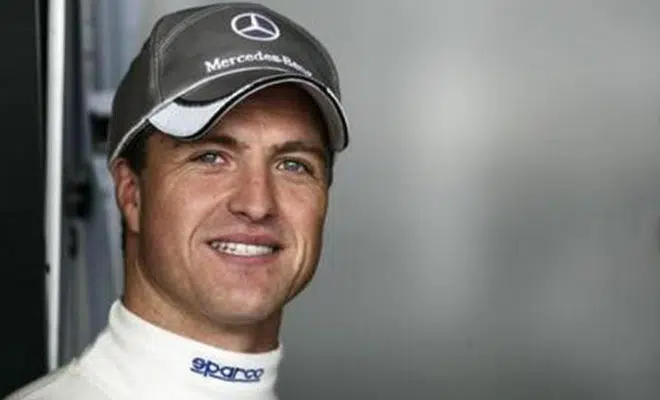Ralf Schumacher, born beneath Michael’s racing shadow, embraces a kart’s embrace at the tender age of three. A karting prodigy, he conquers the German junior championship in ’91 and ascends to a runner-up position the next year in the senior realm. The poetic dance with Formula 3 beckons in ’93, orchestrating his entry into the German F3 ballet in ’94—a performance garnished with a third-place encore. The crescendo follows in ’95, another balletic feat, as he pirouettes to a second-place encore, a rising star in the motorsport symphony. We will discuss the biography of a younger brother who has always sought to surpass his older brother in F1.

F1 biography Ralf Schumacher : Japan to Jordan-Peugeot Triumph
In 1996, he joins the Japanese F3000 championship, clinching two victories while also securing a second position in GT All-Japan. Ralf’s achievements earn him a spot in 1997 with Jordan-Peugeot alongside Giancarlo Fisichella. Initial doubts about securing the contract due to his brother dissipate as Ralf claims third place in his third race in Argentina. Whenever his car holds, he scores points. Ultimately, he tallies thirteen points, finishing eleventh. In 1998, joined by Damon Hill, Ralf delivers results similar to the previous year, catching the eye of Frank Williams.
Ralf Schumacher’s late ’90s run with Williams: resilience, podium success
In 1999, despite a lackluster Williams-Supertec, Ralf performs well, often finishing strongly. He narrowly misses victory at the European Grand Prix due to a puncture but finishes sixth with thirty-five points, the team’s only points that year. In 2000, the arrival of the BMW engine sees Ralf on the podium in Australia, marking a strong start. 2001 becomes Ralf’s standout year, securing his first victory in Imola, followed by two more and outshining Juan Pablo Montoya. He finishes fourth in the championship. The 2002 season is comparable, with Ralf being the only one, alongside Coulthard, to win against the Ferraris.
Ralf’s 2003 Ascent: Poles, Victories, and Challenges
In 2003, Ralf positions himself as a title contender, but the season starts slowly. However, mid-season sees him claim three poles and consecutive victories at the Nürburgring and Magny-Cours, closing in on his brother by nine points. The season’s end is less favorable, finishing fifth in the championship but losing ground to Montoya. The 2004 season is disastrous, marked by Williams’ experimental FW26 and diminishing results. Despite securing pole in Canada after a six-race absence due to a severe Indianapolis crash, Ralf finishes ninth. Williams decides to part ways with him, leading Ralf to join the Toyota team, where he has a commendable season with two podiums and a pole position in Japan.
Ralf’s 2006 Challenges: Toyota’s Struggle
Ralf continues with Toyota in 2006, experiencing reduced effectiveness. The TF106 disappoints, and both drivers struggle. Despite a few points and a lucky podium in Australia, he finishes ahead of teammate Trulli in the championship.
Ralf’s Turbulent 2007 Season
The 2007 season is catastrophic, with Toyota’s uncompetitive car and Ralf overshadowed by Trulli. Criticized heavily, he faces scrutiny from Toyota’s management. Ending the season with only five points, he departs from the Japanese team, likely under pressure.
After unsuccessful tests with Force India, he pauses his F1 career in 2008, joining DTM with Mercedes-AMG. In a 2007 C-Klasse, he has an unremarkable first year, scoring only three points.
With F1 doors definitively closed, he continues in DTM until 2012, concluding his racing career.
F1 biography Ralf Schumacher F1 biography Ralf Schumacher F1 biography Ralf Schumacher
Follow us on Facebook and Twitter to stay updated with the latest Formula 1 news.